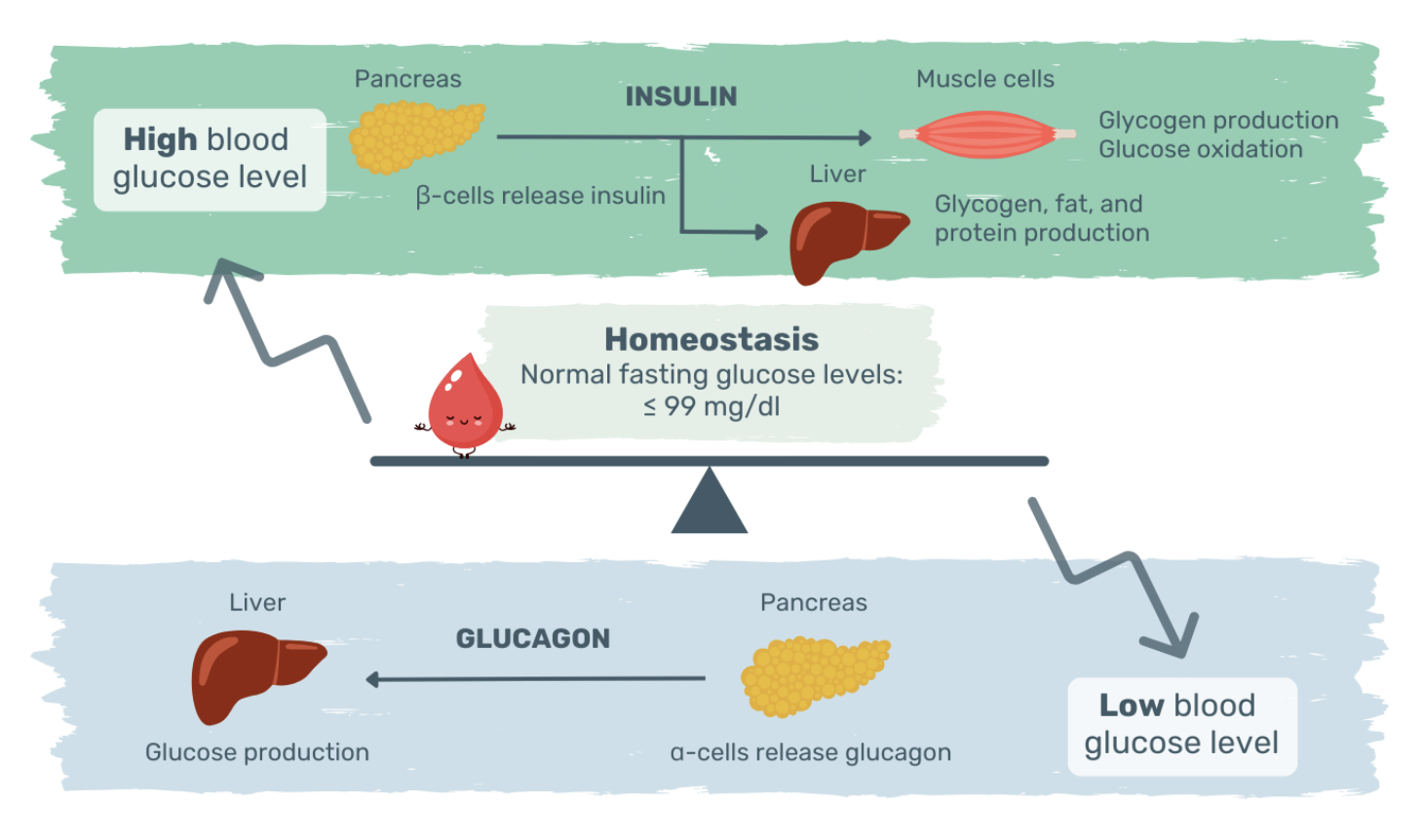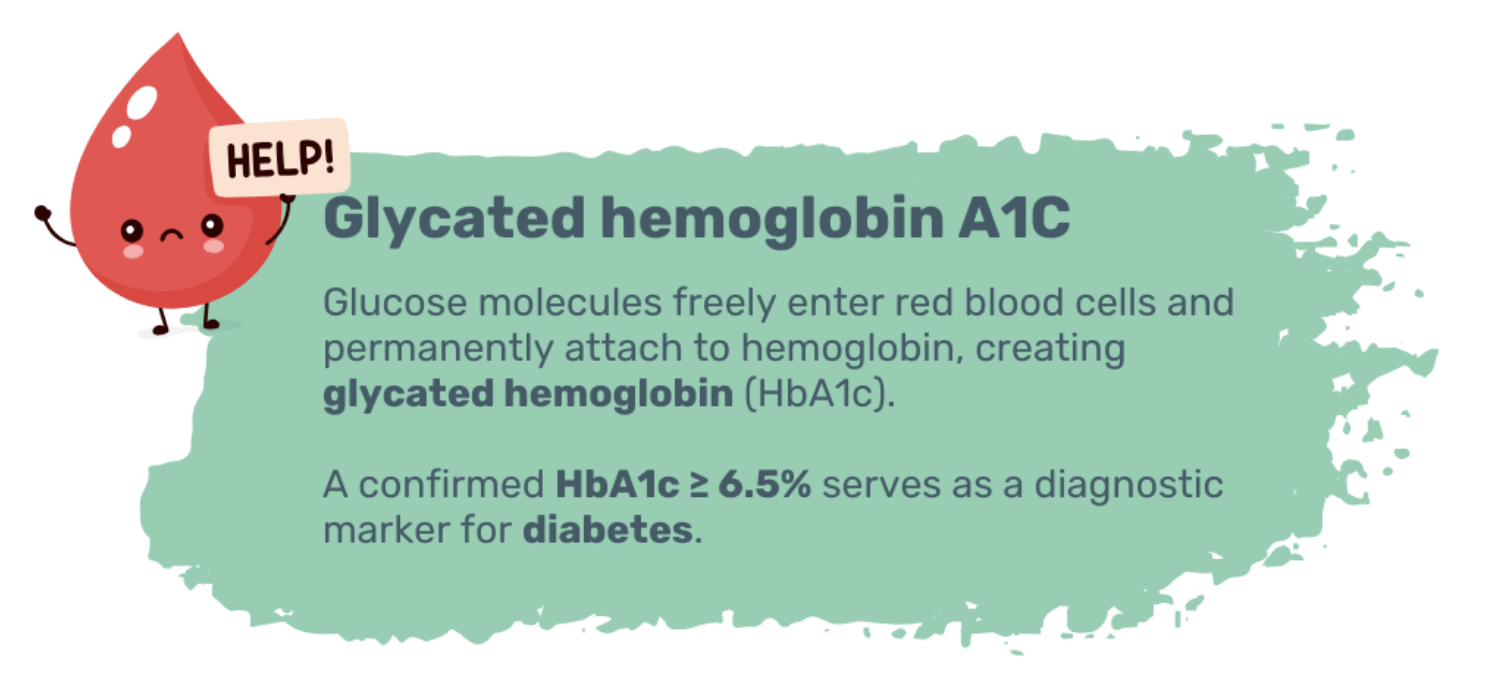Type 2 Diabetes Unveiled: A Guide for Medical Students
By Dr. Miriam Sonntag from the PAN Academy – our online learning platform where you can learn all about nutrition and health.
The International Diabetes Federation (IDF) sounds the alarm with a staggering statistic: 537 million people worldwide were living with diabetes in 2021 alone. That is 1 in 10 adults, and the numbers are projected to skyrocket (1). In this blog post, we will unlock the secrets of type 2 diabetes, the reigning champion in the world of diabetes, accounting for up to 90% of diagnosed cases (1). We’ll unravel insulin resistance and arm you with the tools to combat and prevent this escalating epidemic.
Glucose homeostasis
Before plunging into insulin resistance, let’s review normal conditions first. Glucose fuels our tissues, but maintaining balance is vital. Glucose homeostasis requires the coordination of multiple organs and tissues. Coordinating key organs include the pancreas, liver, muscle and adipose tissue.
The pancreas detects and responds to fluctuating blood sugar levels. It ensures glucose homeostasis by secreting glucagon and insulin – two opposing hormones. When blood glucose levels are low, ɑ-cells in the pancreas release glucagon. Glucagon stimulates hepatic glucose production.
In contrast, when blood glucose levels are high, β-cells in the pancreas secret the anabolic hormone insulin. Glucose enters β-cells through GLUT2 transporters, where it undergoes phosphorylation by glucokinase. This glucose-sensing enzyme matches insulin production to circulating glucose (2).
Insulin enhances glucose uptake in muscle and fat cells. Insulin binds to the insulin receptor on the plasma membrane of the target cell (3). It triggers the translocation of GLUT4 transporter vesicles to the plasma membrane. Once inserted into the plasma membrane, the GLUT4 transporter allows glucose to enter into the cell. Muscle cells have a profound glucose storage capacity, accounting for up to 70% of glucose disposal after meals (4,5).
Insulin lowers blood glucose levels not only by promoting glucose disposal into target tissues. In the liver, insulin suppresses hepatic glucose production and stimulates protein, lipid and glycogen synthesis. In the basal state, it takes very little insulin to suppress hepatic glucose output.
Insulin resistance
Type 2 diabetes is a progressive condition. Insulin secretion declines and its efficacy diminishes. Target cells become insulin resistant. In the early stage, known as pre-diabetes, the pancreas compensates the declining insulin efficiency by producing more insulin. Over time, however, the pancreas begins to wear out and insulin secretion capacity drops. This steady drop in beta cell function decreases glucose sensitivity. By the time a person is diagnosed with type 2 diabetes, the number of functioning beta cells has dropped below 50% (6).
Type 2 diabetes increases the risk of atherosclerosis, neuropathy, and diabetic foot syndrome, as well as nephropathy and retinopathy, a leading cause of visual impairment blindness (1). However, diabetes can be completely reversed with the right approach and early intervention. Let’s have a closer look.
Root cause of insulin resistance
Studies suggest that insulin resistance is caused by excess abdominal and ectopic fat. Excess abdominal fat is also known as central obesity. It correlates with waist circumference. The bigger the waist circumference, the higher the risk of diabetes (7).
The adipose tissue is the only tissue designed to tolerate high levels of fatty acids. Yet, its capacity is limited. When the capacity is exceeded, excess energy triggers adipose tissue inflammation, leading to impaired insulin signalling and increased circulating free fatty acids.
These circulating free fatty acids can then infiltrate the liver, muscle, and pancreas, forming ectopic fat stores. Fat accumulation in the muscle inhibits glucose entry into the cell. GLUT4 transporter vesicles are not translocated to the cell membrane.
Similarly, as fat builds up in the liver, insulin becomes less effective at preventing hepatic glucose production. Moreover, infiltration of free fatty acids into the pancreas increases inflammation, mitochondrial dysfunction and apoptosis. This leads to pancreas fibrosis and β-cell death. Consequently, insulin secretion capacity drops while plasma glucose levels remain elevated.
Type 2 diabetes is a complex disease which can take years or decades to manifest. With an unhealthy body weight contributing to 80-85% of the risk, it’s primarily a lifestyle-related condition (8). However, adopting a lifestyle that promotes a healthy body weight can prevent or reverse type 2 diabetes.
Nutrition as a solution
There is strong evidence that weight loss can delay the progression of insulin resistance to diabetes. In obese patients, a 5-10% weight loss not only improves glycaemic control, it also reduces the need for medications. Moreover, substantial weight loss can lower HbA1c and place diabetes in remission (9).
The DiRECT diabetes trial compared standard diabetes care to calorie restriction for weight loss. After 12 months, remission rates were 46% in the intervention group and only 4% in the control group. This study highlights that remission is weight loss dependent. In the intervention group, 86% of patients who lost >15 kg achieved remission. None in the control group who gained weight achieved remission (10).
If weight loss is key to overcoming type 2 diabetes, how do we achieve it? It is possible to lose weight on any diet, even an ultra-processed junk food one. But, sustaining such a diet in the long term while feeling great is rather unlikely.
Studies suggest that food quality plays a crucial role in preventing or reversing diabetes. Consuming excess calories, saturated fat, cholesterol, red meat and added sugar amplifies the risk of diabetes (11). Conversely, incorporating whole plant foods can lower the risk of diabetes (11).
In the European Prospective Investigation into Cancer and Nutrition (EPIC)-NL study of over 38,000 participants, researchers concluded that every 5% of calories from protein, particularly animal protein, resulted in a 30% increase in the risk of developing T2D. No such association was found for plant-based protein (12).
Moreover, in a study comparing a low fat vegan diet to the American Diabetes Association’s standard care, the plant-based group achieved remarkable results: They reduced medications two-fold (48% vs. 23%), lowered HbA1c three times more (-1.23% vs. -0.38%), lost twice as much weight (6.5 kg vs. 3 kg) and had double the reduction in LDL cholesterol (21.2% vs. 9.3%) (13).
Plant-based dietary patterns can prevent and treat diabetes. Yet, not all plant-based food is healthy. Data from three US cohort studies, tracking over 200,000 health professionals for 20+ years, showcased the impact of food decisions. Diets emphasising whole plant foods saw a 34% decreased risk of diabetes. In contrast, plant-based diets rich in processed foods had a 16% increased risk of diabetes (14).
Unprocessed plants are rich in fibre, which fuels your gut bacteria. Keeping your microbes well-fed means they produce a multitude of beneficial metabolites. Short chain fatty acids, like butyrate, can improve glucose clearance from the blood (15).
In contrast, processed foods should be limited or avoided. Swapping saturated fats with polyunsaturated fats or unrefined carbohydrates, for example, can improve insulin sensitivity (16). Moreover, the more processed foods we eat, the higher the risk of diabetes (17).
Take-home message
Whole plant foods not only reduce the risk of developing type 2 diabetes, they can also restore normal physiology in patients suffering from existing insulin resistance or type 2 diabetes. Moreover, plant foods have a lower calorie density than ultra-processed and animal foods. They can help create a calorie deficit and promote a healthy body weight.
Ready to unveil the benefits of a whole food plant-based diet to your patients? Explore our tips below, or discover our Change Talk cards. They are designed to assist your patients in overcoming any objections towards positive change.
Tips for encouraging healthy eating in your patients
Focus on the foods you add, not the ones you remove.
Start with plant foods you already know and enjoy, then expand your preferred list.
Plantify your favourites: Swap unhealthy ingredients for nourishing plant alternatives.
Eat the rainbow: Strive for 30 different plants per week.
Keep fresh fruit at hand: It’s a perfect and healthy snack to satisfy sweet cravings.
Bounce back: accept relapses, reset and resume healthy eating.
Additional Information:
-
Dr Miriam Sonntag is the Medical Content Executive of the online learning platform, PAN Academy. Having worked in basic research, she knows how to decipher complex information. Working now at PAN, she scans and pours over scientific papers and books. She breaks down the latest nutritional research into actionable advice for everyday life. She is committed to sharing the bigger picture of why it is good to put more plants on your plate.
-
International Diabetes Federation, 2021. IDF Diabetes Atlas 2021. Available from: https://diabetesatlas.org/atlas/tenth-edition/
Bae et al., 2010. Transcriptional Regulation of Glucose Sensors in Pancreatic β-Cells and Liver: An Update. Available from: https://doi.org/10.3390%2Fs100505031
Petersen & Shulman, 2018. Mechanisms of Insulin Action and Insulin Resistance. Available from: https://doi.org/10.1152%2Fphysrev.00063.2017
Jensen et al., 2011. The Role of Skeletal Muscle Glycogen Breakdown for Regulation of Insulin Sensitivity by Exercise. Available from: https://doi.org/10.3389%2Ffphys.2011.00112
Chadt & Al-Hasani, 2020: Glucose transporters in adipose tissue, liver, and skeletal muscle in metabolic health and disease. Available from: https://doi.org/10.1007/s00424-020-02417-x
Taylor, 2013. Banting Memorial lecture 2012: reversing the twin cycles of type 2 diabetes. Available from: https://doi.org/10.1111/dme.12039
Jayedi et al., 2022. Anthropometric and adiposity indicators and risk of type 2 diabetes: systematic review and dose-response meta-analysis of cohort studies. Available from: https://doi.org/10.1136/bmj-2021-067516
Shah, 2015. Assessing the risk of diabetes. Available from: https://doi.org/10.1136/bmj.h4525
ElSayed et al., 2022. 8. Obesity and Weight Management for the Prevention and Treatment of Type 2 Diabetes: Standards of Care in Diabetes—2023. Available from: https://doi.org/10.2337/dc23-Sint
Lean et al., 2018. Primary care-led weight management for remission of type 2 diabetes (DiRECT): an open-label, cluster-randomised trial. Available from: https://doi.org/10.1016/S0140-6736(17)33102-1
Kolb & Martin, 2017. Environmental/lifestyle factors in the pathogenesis and prevention of type 2 diabetes. Available from: https://doi.org/10.1186/s12916-017-0901-x
Sluijs et al., 2009. Dietary Intake of Total, Animal, and Vegetable Protein and Risk of Type 2 Diabetes in the European Prospective Investigation into Cancer and Nutrition (EPIC)-NL Study. Available from: https://doi.org/10.2337/dc09-1321
Barnard et al., 2006. A Low-Fat Vegan Diet Improves Glycemic Control and Cardiovascular Risk Factors in a Randomized Clinical Trial in Individuals With Type 2 Diabetes. Available from: https://doi.org/10.2337/dc06-0606
Satija et al., 2016. Plant-Based Dietary Patterns and Incidence of Type 2 Diabetes in US Men and Women: Results from Three Prospective Cohort Studies. Available from: https://doi.org/10.1371%2Fjournal.pmed.1002039
Salamone et al., 2021. The relationship between gut microbiota, short-chain fatty acids and type 2 diabetes mellitus: the possible role of dietary fibre. Available from: https://doi.org/10.1007/s00592-021-01727-5
Luukkonen et al., 2018. Saturated Fat Is More Metabolically Harmful for the Human Liver Than Unsaturated Fat or Simple Sugars. Available from: https://doi.org/10.2337/dc18-0071
Moradi et al., 2021. Ultra-Processed Food Consumption and Adult Diabetes Risk: A Systematic Review and Dose-Response Meta-Analysis. Available from: https://doi.org/10.3390%2Fnu13124410


